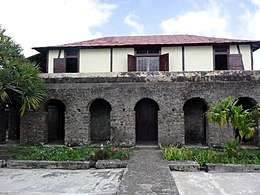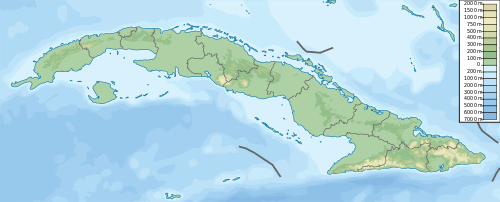Archaeological Landscape of the First Coffee Plantations in the South-East of Cuba
The Archaeological Landscape of the First Coffee Plantations in the South-East of Cuba are the remains of 19th-century coffee plantations located in the foothills of the Sierra Maestra. During the 19th and early 20th centuries, eastern Cuba was primarily involved with coffea cultivation. The remnants of the plantations display the techniques used in the difficult terrain, as well as the economic and social significance of the plantation system in Cuba and the Caribbean.
| UNESCO World Heritage Site | |
|---|---|
 Cafetal La Isabelica, ancient coffee plantation in foothills of Sierra Maestra, Santiago de Cuba, Cuba | |
| Location | Santiago de Cuba Province and Guantánamo Province, Cuba |
| Criteria | Cultural: (iii), (iv) |
| Reference | 1008 |
| Inscription | 2000 (24th session) |
| Area | 81,475 ha (314.58 sq mi) |
| Coordinates | 20°01′48″N 75°23′29″W |
 Location of Archaeological Landscape of the First Coffee Plantations in the South-East of Cuba in Cuba | |
In 2000, the Archaeological Landscape of the First Coffee Plantations in the South-East of Cuba was added to the UNESCO list of World Heritage Sites.[1]
Under UNESCO, the "Archaeological Landscape of the First Coffee Plantations in the South-East of Cuba" meet two criteria that allows it to be a world heritage site. Under UNESCO it is seen to meet criteria ii & iv, which means under criteria (ii) to exhibit an important interchange of human values, over a span of time or within a cultural area of the world, on developments in architecture or technology, monumental arts, town-planning or landscape design. And under criteria (iv) to be an outstanding example of a type of building, architectural or technological ensemble or landscape which illustrates (a) significant stage(s) in human history.
- Cafetal Isabelica, Mill to process beans
- Cafetal Isabelica, Drying place called secadero or tendal
 Cafetal Isabelica, Tools and slave chains
Cafetal Isabelica, Tools and slave chains- Cafetal Isabelica, Interior of the property
See also
References
- "World Heritage Committee Inscribes 61 New Sites on World Heritage List". UNESCO. Retrieved 15 May 2015.